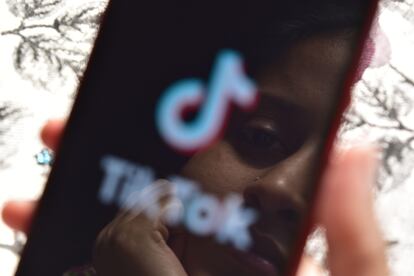Just shut up and buy: Why no one has friends on TikTok
Social media networks that began as platforms for socializing have increasingly become market showcases

Words gradually mutated to adapt to a new reality. People stopped having friends and started amassing followers. Conversations disappeared to give way to trends. In the United States, social networks began to be called social media. Platforms that had once been used to connect with friends and family were becoming a vehicle to connect customers with markets; viewers with content creators. Walls and home pages became filled with advertising and videos from influencers, newspapers and celebrities, burying friends’ posts in a constant stream of consumer-oriented content. Photos of the cousin on vacation in Mexico were replaced by photos of Chiara Ferragni on vacation in Malaysia. Long gone is the pithy remark from a high school friend. Now, all we see are the latest viral dance moves. Social networks have stopped reminding us of birthdays in order to sell us shoes. And so we started to mute our voices; to consume content with cathodic passivity and stop creating it. In other words, we shut up.
According to a Hootsuite survey, in a clear trend, only 33.9% of TikTok users post on the platform, compared to 69.9% of Instagram users. “There was a period, in the early days of social media, when we were all sharing a lot more,” tech analyst Matt Navara told EL PAÍS. “It was new and exciting then, but we’ve learned that the things we share publicly online come with a number of risks. And we’re more cautious.”
The dark forest theory — a place that is silent, not from lack of life, but for fear of predators — is now being applied to social networks by authors like Yancey Strickler. The fear of content going viral, of an idea being misinterpreted or of losing control over a photo has led many to seek refuge in more closed circles, such as messaging apps. “This has been accompanied by another phenomenon,” Navara pointed out. “A boom in the creator economy, with a lot of people able to monetize their creative talents.”
These two phenomena are not absolutes, but they are magnified by the power of the algorithm. All social networks are interested in promoting advertising content for obvious reasons, but also content that keeps the user using. And videos like “15 secret haunts less than an hour from Madrid” are measurably more engaging than photos of our coworker’s wedding. It is something that Instagram has wised up to, hence its algorithm being assembled around the figure of the influencer, allowing brands to build huge audiences. But it is TikTok that has changed the rules of the game, almost completely erasing friends and acquaintances from the equation. Only 15% of users of this platform communicate directly with their contacts. But it works. So much so that Instagram, Facebook and Twitter are trying to copy the formula.
How does the shift from active to passive use of social networks affect the user? That’s the question Philippe Verduyn, professor of Psychology at Maastricht University, posed in a joint study with the University of Michigan. “Many have examined how social networks influence mental health, but few consider that this depends on how they are actually used,” Verduyn told EL PAÍS. According to his findings, active use “stimulates feelings of connectedness. By reaching out to others, people receive support or information and so feel connected.”
Sharing photos, engaging in conversations and voicing opinions on any topic in a friendly way — starting a fight on Twitter doesn’t count, according to Verduyn — can brighten our day in the same way as having coffee with a friend. Viewing others’ photos and conversations would be tantamount to watching that friend from afar over coffee without sitting at the table with them. Whereas “passive use harms mental health by stimulating harmful social comparisons and associated feelings of envy or inferiority,” as Verduyn pointed out.
Still, we tend towards passive use. “Some studies suggest that nowadays passive use is about twice as frequent as active use,” said Verduyn. “To begin with, passive use requires less effort than active use, and many people also enter the networks to search for information and keep abreast of what is happening in their social circle.”
But there’s another reason: social networks have evolved to encourage this type of consumption. When opening a Facebook account in 2008, the user was confronted with a bar that asked, “what are you thinking?” and a button to search for friends. Now, when a user starts an account on TikTok 15 years later, they are connected to a continuous stream of content chosen by the algorithm. Between 2008 and 2023, social networks have realized that the best way to retain users is not to ask them what they think, but to ply them with viral videos. And so, instead of the two-way street full of ideas and conversation, we now have superhighways of constant content. Facebook launched groups, pages and the news feed, encouraging users to share content posted by others. LinkedIn mimicked the move. Twitter, already primarily a publishing platform, added the “retweet” feature, which facilitated the viral spread of content.
Cyberpsychologist Linda Kaye, a professor at Edge Hill University and author of the study Exploring the “socialness” of social media, has long been flagging up this trend, and she adds reactive use to active and passive use. “This would be reacting to the content of others, such as giving likes,” she said while explaining that this doesn’t have the same positive effect as active use. It would be as if we were greeting our colleagues from afar in a coffee shop without actually sitting down at the table with them. And that is the model we are moving towards. The social networks of the future resemble a coffee shop with content creators sitting at the senior tables while the average user wanders around throwing out greetings, hearts and thumbs up.
“Social media has evolved to be more personalized,” Kaye explained. “And this has primarily served to increase user attention and engagement. The engagement is with ads rather than with users preferring more two-way types of interaction.”
This is what writer Cory Doctorow dubbed in a Wired article as the “weeding process,” a growth model that almost all social networks have followed. Once the platform has retained users, content creators and media, and made them dependent, they begin to change algorithms to boost paid content and dilute conversations into a stream that generates revenue. Doctorow quotes Cat Valente who summed it up as follows: “Stop talking to each other and start buying things!”
Sign up for our weekly newsletter to get more English-language news coverage from EL PAÍS USA Edition
Tu suscripción se está usando en otro dispositivo
¿Quieres añadir otro usuario a tu suscripción?
Si continúas leyendo en este dispositivo, no se podrá leer en el otro.
FlechaTu suscripción se está usando en otro dispositivo y solo puedes acceder a EL PAÍS desde un dispositivo a la vez.
Si quieres compartir tu cuenta, cambia tu suscripción a la modalidad Premium, así podrás añadir otro usuario. Cada uno accederá con su propia cuenta de email, lo que os permitirá personalizar vuestra experiencia en EL PAÍS.
¿Tienes una suscripción de empresa? Accede aquí para contratar más cuentas.
En el caso de no saber quién está usando tu cuenta, te recomendamos cambiar tu contraseña aquí.
Si decides continuar compartiendo tu cuenta, este mensaje se mostrará en tu dispositivo y en el de la otra persona que está usando tu cuenta de forma indefinida, afectando a tu experiencia de lectura. Puedes consultar aquí los términos y condiciones de la suscripción digital.
More information
Archived In
Últimas noticias
Chris Martin, Taylor Swift, Elijah Wood and other famous wedding ‘crashers’
‘How does it feel to be a failure?’: Elizabeth Berkley’s journey from ‘Showgirls’ ridicule to vindication
The story of the Málaga virus: The code that haunted Google’s cybersecurity center director for 30 years
The impact of Ecuador’s mega-prison: A polluted river, cleared forests and military checkpoints
Most viewed
- Christian Louboutin: ‘Young people don’t want to be like their parents. And if their parents wear sneakers, they’re going to look for something else’
- The low-cost creative revolution: How technology is making art accessible to everyone
- All the effects of gentrification in one corner of Mexico’s Colonia Roma
- Liset Menéndez de la Prida, neuroscientist: ‘It’s not normal to constantly seek pleasure; it’s important to be bored, to be calm’
- December Social Security and SSI payments: Dates, double checks and the 2026 COLA increase











































